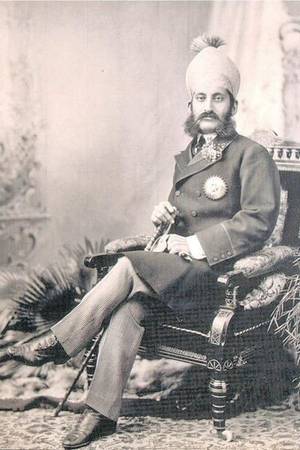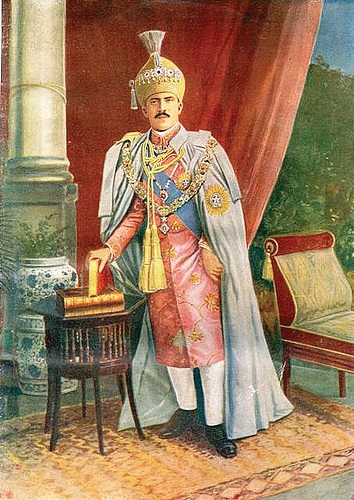Hyderabad . ANDHRA PRADESH :

The sixth Nizam Mahboob Ali Pasha is remembered for combining tradition with modernity
Among the rulers of all the native states in British India, Mahboob Ali Pasha, the sixth Nizam of Hyderabad is reputed to have had the most lavish court. Born in August, 1866, Mahboob came to the throne at the age of three after the death of his father, Afzal ud Daulah. Mahboob Ali, thus knew no day when he was not the King.
A Regency under Sir Salar Jung I was set up for the young Nizam till he came of age. The Viceroy, Lord Ripon came to Hyderabad for the investiture ceremony held on February 5, 1884 and presented the Nizam a diamond-studded gold sword on the occasion.
Mahboob Ali was a perfect example of a Victorian Prince. He had a great taste for western culture and modern ways of life.
His English tutor, Major John Clark (who had earlier tutored the Duke of Edinburgh) had instilled in young Mahboob the customs and manners of high English society. As a result he imbibed great taste for all that was western. His western etiquette was so perfect that there was a rumour among the courtiers that the Nizam visited European countries incognito without the knowledge of any one!
His obsession for clothes and cars was legendary. His collection of garments was one of the most extensive in the world of his time.
The best English tailors were brought to Hyderabad to stitch the Royal robes combining tradition with modernity. There was a new dress for every day and he never wore the same dress for the second time.
It is no wonder that Mahboob Ali had a huge wardrobe in his palace that ran for more than hundred feet in length, considered to be the longest in the world. As his wardrobe was on the first floor of the palace, a lift was fitted for the Nizam to access his wardrobe every day with ease.
It is interesting to note that this hand-operated wooden lift at the Purani Haveli palace, in its shining best is still in perfect working condition.
His passion for cars was unparalleled and owned a good fleet of them. A Rolls Royce Silver Ghost that was made to order but delivered after he died in 1911, is now on display in the Chowmahalla palace fully restored, due to the efforts of Princess Esra Jah wife of the present Mukharam Jah.
The resources of the Nizam as well as the spirit of the times to which he belonged never discouraged lavish spending of money. Hyderabad came to be known for Mahboob Ali’s extravagant entertainments and lavish hunting expeditions.
Interest in medicine
It was under Mahboob Ali’s patronage, that Hyderabad Chloroform Commission was set up in 1889 and Chloroform as a safe anesthesia agent in surgeries was proved by Dr. Edward Lawrie, Principal of Hyderabad Medical School. The Nizam was personally interested in the work of the Commission. Two Hyderabadi doctors, Dr. M.G. Naidu (husband of Sarojini Naidu) and Dr. S. Mallanna (father of the future Gen. S.M. Srinagesh) were sent to England with funds provided by the Nizam to prove the efficacy of Chloroform in surgeries.
The British Medical Association journal, Lancet, hailed the work of this Commission. Mahaboob Ali, personally being interested in healing was famously known to administer a herb-based medicine to cure snake bite. During his reign, the first Hyderabad- Nagpur Railway line was laid in 1874. The advent of telegraph, telephone and electricity opened up Hyderabad towards economic growth.
Chirag Ali, a well known educationalist from Aligarh was invited by Mahboob Ali to spread English education in the Nizam’s dominions. Mahboob College in Secunderabad and Nizam College in Hyderabad stand testimony to the development of higher education initiated by Mahaboob Ali Khan. Aghornath Chattoadhyay, the father of Sarojini Naidu, the first Indian to have obtained Ph.D in Biology from Edinburgh University, was the first principal of the Nizam College.
Mahboob Ali Khan was a good polo player and an excellent marksman. He was probably the first Indian prince to have a court photographer, Deen Dayal. With his wonderful skills in photography, Deen Dayal, on whom the Nizam conferred the title, Raja, immortalised the Nizam and his times. Raja Deen Dayal employed in his studio an English lady to help him in taking the photos of the women members in the Nizam’s Palace.
Mahaboob Ali passed away on August 29, 1911 when he was hardly 45 years and was succeeded by his son, Mir Osman Ali Khan, regarded as the world’s richest man but the most frugal of all the Nizams, an antithesis to his flamboyant father.
Among the numerous expensive jewels that Mahboob possessed during his reign was the famous Jacob Diamond weighing 162 Carats, bought from the reputed London jeweller, Jacob.
Years later, Osman Ali Khan used this fabulous diamond, said to be next only to Kohinoor, as paper weight, the purpose for which Mahaboob Ali bought it.
Mahboob Ali also ever lives in the minds of the gastronomists, be the natives or visitors to this city for the aroma and the taste of the distinct Hyderabadi dhum biryani, the perfection for which the Nizam, Mahboob Ali Pasha justifiably took pride.
source: http://www.thehindu.com / The Hindu / Home> Society> History & Culture / by K.S.S.Seshan / February 02nd, 2017









